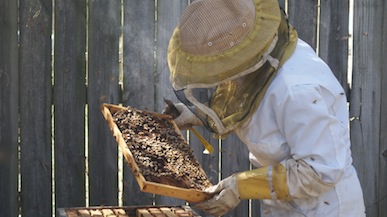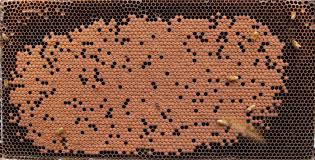 Starting a bee hive on your property is an exciting event. It’s akin to having a new baby in the house — or 15,000 new babies! And as with a new baby, it can bring with it some anxiety about the health and well being of the creatures in your midst. The best way to make sure your hive is flourishing is to ascertain that the queen is laying new brood.
Starting a bee hive on your property is an exciting event. It’s akin to having a new baby in the house — or 15,000 new babies! And as with a new baby, it can bring with it some anxiety about the health and well being of the creatures in your midst. The best way to make sure your hive is flourishing is to ascertain that the queen is laying new brood.
1. Choose a sunny, warm day. About a week or two after you hive the queen plan to perform your hive check. On a sunny, warm day many bees will be away from the hive on foraging duty, thus reducing the number of bees you will be disturbing.
2. Suit up and smoke down the hive. Wearing a protective suit will give you confidence to move among the bees. Smoking down the hive helps to calm the bees. It prevents a triggering of the bees’ defensive response by masking alarm pheromones released by guard bees in response to the hive invasion or to bees killed during the work.
3. Open up the hive and inspect a frame in your brood chamber. Remove the top cover and set it aside. Use your hive tool to pry out a frame, trying first the frame that seems to have the most bee activity around it. Use your bee brush to gently brush away any bees that get in your way, brushing them back into the hive, but do not brush the bees off the frame itself. You are seeking the queen, and she and her attendants will remain on the frame.
4. Continue inspecting frames until you find the queen. Even if your queen isn’t marked, it’s usually fairly easy to identify her by her size and manner. The queen will be longer and larger than the other bees and you can witness the interaction of the other bees with her. It’s a definite power relationship! Note that if you are inspecting a hive that has more than just a brood chamber, your queen may decide to lay her brood anywhere in the hive, so if you don’t find her on frames in the brood chamber, check out the frames in your honey super too.
 5. Identify brood cells. You are looking for capped cells that looks like those in the picture. They will appear brownish and look a little like leather. The more capped cells, the more brood. A queen who is actively laying brood is a healthy queen who is confident that she reigns over a healthy hive that can adequately support the feeding of new bees.
5. Identify brood cells. You are looking for capped cells that looks like those in the picture. They will appear brownish and look a little like leather. The more capped cells, the more brood. A queen who is actively laying brood is a healthy queen who is confident that she reigns over a healthy hive that can adequately support the feeding of new bees.
6. Take palliative care as necessary. A queen who is not laying brood, or is only laying a small amount of brood, is sending the signal that she is concerned about the resources available in the hive to support new life. If you are not feeding your bees sugar water and the nectar flow has yet to begin, add a sugar-water feeder to your hive. A queen may also be showing signs of her own health deterioration. In some cases, you might find that the queen did not survive the hiving process. In that instance, unless the hive seems to be so robust it can create a new queen (rare in a new hive) you will need to start the hiving process again with a new bee package, possibly waiting until the following spring to do so.
7. Replace the frame, close back up the hive and leave the bees in peace. Perform your hive check as quickly and efficiently as possible. Invasive hive checks cause stress to the bees and are best kept to a minimum.
8. Watch for baby bees on orientation flights. When the brood you have identified hatches, the baby bees will start leaving the hive to take their orientation flights. You can watch them flying in figure eight grooves in front of the hive. It’s quite amazing to watch their deliberate patterns.
© 2014 Grateful Trees & Bees

